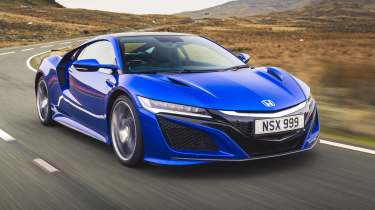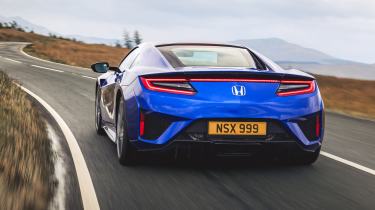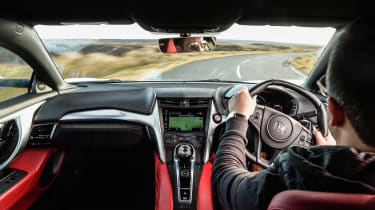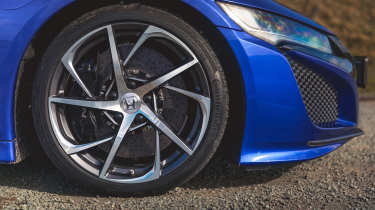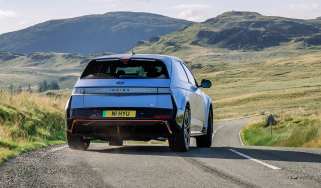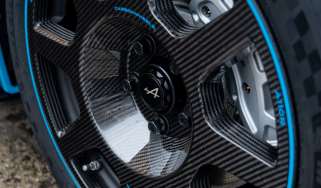Honda NSX (2016-2022) review – Japan's answer to the Porsche 911 Turbo
The NSX melds technology and tactility to impressive effect, but still lacks the ultimate emotional appeal of the best supercars
As the successor to Honda’s game-changing ’90s supercar of the same name, the 2016 NSX received a mixed reception upon its launch. Rather than bringing the original NSX recipe up to date, the new offering added turbochargers and hybrid assistance to the mix, ingredients that many believed went against the purist principles of the earlier models.
Before its arrival, however, the reborn NSX had already been through numerous revisions behind closed doors, with initial plans beginning once the NA2 version had gone off sale way back in 2005. You may have seen grainy trackside YouTube videos of a V10-powered, front-engined NSX prototype being tested in 2008, but this concept was ditched not long after amidst the global financial crisis, with Honda scrapping all non-essential projects. When new CEO Takanobu Ito took the helm in 2009, he sought an NSX that was ‘clever, with a focus on dynamic development’. That car would be the mid-engined, hybrid-powered NC1.
> Why the Honda NSX-R is one of the most significant cars of the last 25 years
Honda’s engineers settled on a 3.5-litre twin-turbocharged V6 assisted by a trio of electric motors – two on the front axle and one between the engine and transmission – enough for a combined 573bhp and 476lb ft of torque. While the ‘holy trinity’ of Ferrari LaFerrari, McLaren P1 and Porsche 918 Spyder had brought hybrid assistance into the spotlight for hypercars a few years prior, it was all but unheard of in the more attainable supercar sector at the time, making the NSX a curious and unique machine.
Although it can operate in silent, full-electric mode, the hybrid assistance is primarily for torque fill. The result is acceleration to rival that of the very quickest supercars, drive sent to all four wheels for a 2.9sec 0-62mph sprint. Despite being a first-generation hybrid supercar, the NC1 – much like the original NA1 and NA2 in their heyday – is exceptionally well refined, perhaps slightly to its detriment. Compared with competitors such as the McLaren 540C and Porsche 911 Turbo S the NSX does lack some character. The steering is quick and precise but doesn’t provide an awful lot of feedback, and the powertrain is not the most musical, either. However, the expert integration of the V6 and e-motors along with the car’s engaging dynamics make it a worthy consideration – one that could be a future classic, too.
Buying one used
While not particularly useful for those looking for a used bargain, values have stayed relatively steady since production came to an end in 2022. The low take-up for the model no doubt helps – just 2908 were built in total, with 150 of those allocated to the UK, making it considerably rarer than most of its European rivals. Consequently there are usually just a handful to be found in the classifieds at any given time.
More reviews
Prices began at £149,950 from the factory, but today they range from £100,000 to £130,000. And whatever you pay you’ll almost certainly be getting a very lightly used example: mileages in the 20,000s or even 10,000s are uncommon, while many have barely gone beyond delivery figures. For this very reason it’s hard to gauge the true reliability of the NC1 just yet, but as long as you’re aware of battery degradation over time, its Honda engineering should stand you in good stead.
Honda NSX: in detail
- Performance and 0-62mph time > The combination of V6 petrol and three electric motors delivers sub 3sec 0-62mph
- Engine and gearbox > Hybrid drivetrain is beautifully integrated, while the nine-speed twin-clutch is a quick and smooth ally
- Ride and handling > Given its weight, the four-wheel drive Honda is agile and engaging, plus rides with reasonable suppleness
- MPG and running costs > It’s not exactly eco-friendly, but hybrid powerplant means NSX is nearly as efficient as a Civic Type R
- Interior and tech > Cabin looks the part, what with its digital dials and beautiful finish, but layout is a little haphazard
- Design > It perhaps tries a little too hard, but chiselled and low-slung Honda is every inch the exotic
Prices, specs and rivals
The naturally-aspirated trio of the Porsche 911 991.1, first generation Audi R8 V10 Plus and Ferrari’s 458 provided the benchmark for the second coming of the NSX. These cars represented the supercar establishment during the NSX’s development, but the McLaren 540C, 992-generation Porsche 911 Turbo and Audi R8 V10 Plus upped the ante in this fiercely contested segment.
The Audi R8 V10 Plus occupied the same financial bracket and sticks to the old naturally aspirated school of thought – the last model still doing so in the mainstream supercar arena. The NSX suffers over a 30bhp deficit to the R8, but boasts significantly more twisting power with 476lb ft of torque compared to the R8’s 413lb ft.
The Honda flagship also had competition from McLaren’s entry-level 540C, in essence a cheaper 570S. Retaining all the granular tactility of the 570S, but with a little less outright go (although you’d struggle to tell on the road, where it delivers the same laggy whizz-bang power delivery of the more expensive version). The Woking-based supercar may drop a few car lengths to the NSX when both are driven in anger, but it is the more engaging to drive of the two.
Opt for the non-S Porsche 911 Turbo and you'd pay £134,400, though the £155,970 Turbo S falls squarely into NSX territory. Little more needs to be said of the 911 Turbo’s phenomenal point-to-point pace, which exists within the practical 911 package that can even accommodate a pair of (toddler-sized) passengers in the second row – a unique feature amongst these rivals.
The BMW i8 was the NSX’s closest rival in terms of technical anatomy. A single electric motor deploys power at the front axle to supplement the 1.5-litre petrol unit driving the rear; the combined output of the hybrid powertrain is 357bhp. The BMW i8 though, operates on a lower, sports performance plain rather than supercar echelon within which the NSX competes.
Honda NSX (NC1, 2016-2022) specs
| Engine | V6, 3493cc, twin-turbo, plus three electric motors |
| Power | 573bhp |
| Torque | 476lb ft @ 2000rpm |
| Weight | 1776kg |
| Power-to-weight | 328bhp/ton |
| 0-62mph | 2.9sec |
| Top speed | 191mph |
| Price new | £149,950 |
| Value today | From £100,000 |
